 January 2009
Amsterdam, Arnhem and the Arabesque
For days leading up to this trip,
the conversations I had with friends all went the same way.
"Doug, what are you up to this
weekend?"
"Going to Amsterdam."
That reply was usually met with open eyes and a
slight smirk that conveyed suspicion. I could tell what they wanted to say next. "Up
to no good, aren’t you?" Instead, it was followed by "Hmmm"
and a change of topic.
Undoubtedly, people were suspicious of me,
particularly because Amsterdam has a bit of a reputation. Furthermore, in my past life --
before marriage, a child, and middle age -- I more than likely would have been up to no
good if I was going to Amsterdam. "No good" still runs through my mind at least
once or twice a day -- more so when I’m in Las Vegas -- but I don't act on those
impulses anymore. Instead, they stay locked in my head.
The truth of the matter is that in this case I
wasn't going anywhere that could get me into trouble. I was traveling to Amsterdam en
route to a smaller city called Arnhem, where high-end-audio companies Crystal Cable and
Siltech have their headquarters. The two firms are sister companies whose structure and
operations I'll explain in a factory-tour article. For the purposes of what I'm explaining
here, it's just important to know that Siltech has been around for about 25 years, while
Crystal Cable is only about five years old. The former is run by Edwin van der Kley, while
the latter has Gabi van der Kley at the helm. They're husband and wife, but as I learned
both are in firm control of their own companies and have their own ideas on how things
should be run.
Of the two, it's Crystal Cable that has been
getting most of the press these days because of an almost endless procession of new
products. Usually, these have been cables -- obvious given the name of the firm. This
time, though, Crystal Cable was debuting something different: the Arabesque loudspeaker, a
unique product that was conceived by Gabi and marries the three core principles by which
she runs her business: (1) technical proficiency combined with (2) fanatical attention to
musicality, both delivered in an end product that is (3) elegant and attractive. That's
what Crystal Cable and its products are about.
I made two videos about the Arabesque speaker for
our SoundStage! V sister
site (part 1, part 2).
They went live in November. This article will not only tell you more about the speaker,
but what it took for me to get to Arnhem and hear it -- a trip that literally involved
planes, trains, and automobiles.

Amsterdam's Schipol Airport, November 23, 2008.
The traveling time from Ottawa, Canada, where I
live, to Amsterdam is about 12 hours. I had to fly all night and transfer in Frankfurt,
Germany, a transfer that isn't all that quick or easy to make. Travelers have to go
through customs, climb up and down seemingly endless flights of stairs (with luggage in
hand), walk down long hallways, pass security, walk more hallways, and then wait for the
next flight. Good luck finding good food.
As a result, as my flight approached Amsterdam, I
was exhausted. What's more, Amsterdam is six hours ahead of Ottawa, so I wasn't just
tired, but my body's clock was completely out of sync. That's not all. Half asleep on the
final part of the last leg, I heard the landing gear open followed by the announcement
telling us we were about to land. Then we hit the runway hard -- hard enough that
exhaustion and jet-lag were knocked clear out of me. I was suddenly wide awake and alert
and wondering if I had to search for an emergency exit. I quickly looked out the window
and realized that we landed in the middle of a snowstorm, the first for The Netherlands
this winter, and the pilot brought the plane down "hot." But I was there.
Frankly, I wasn't expecting the weather to be
worse in The Netherlands than it was back home in Canada. In fact, anywhere in the world
that you go the weather is rarely worse than in Canada, unless you go to Iceland or
Siberia or someplace like that. But, just my luck, the moment I arrived in The
Netherlands, it was covered in snow, something that, I was told, rarely happens given the
country's proximity to the ocean. Thankfully, I wasn't in any hurry to get anywhere
because I wasn't scheduled to go to Crystal Cable/Siltech until the next day, Monday. So I
checked into my hotel at the airport and went to the mall. Yes, the mall.
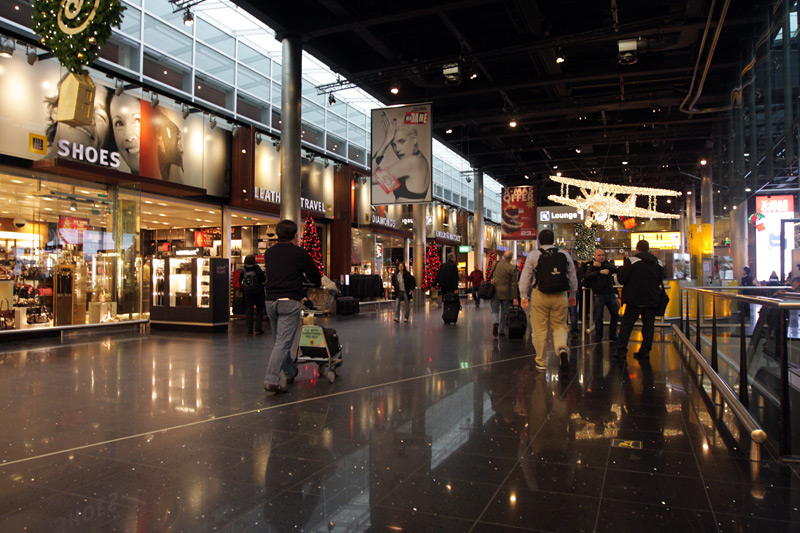
The Schipol Airport mall. "Yes!"
With a snowstorm happening, roads congested, and
jet-lag setting in, I had no inkling to go outside or downtown, even if there was
opportunity to be up to "no good," which I'm sure there was. (With T-shirts
everywhere that say "Good girls go to heaven. Bad girls go to Amsterdam," the
folks in Amsterdam certainly tempt you with their reputation.) Frankly, I was just
thankful to discover that Amsterdam's Schipol Airport has a killer mall inside, replete
with stores, restaurants, and Starbucks coffee shops. What's more, the mall is open seven
days a week from 6 a.m until 12 p.m. For the night, I was set.
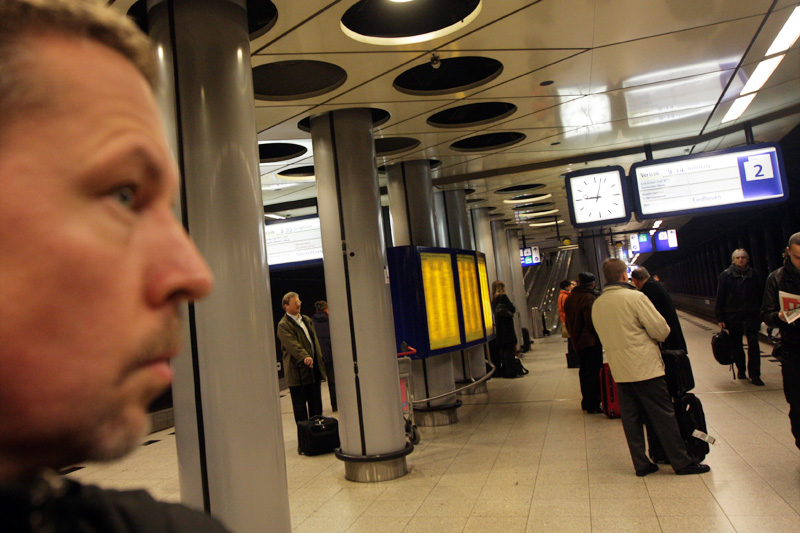
The nervous tourist at the train station.
The next morning I jumped out of bed early and
was eager to get to the train and continue on my journey. Admittedly, though, I was a
little concerned and nervous. I've been traveling to Germany for the High End show for
seven years, usually with Jeff Fritz, and neither of us has figured out the ticketing
system for the train. The Germans run everything with high efficiency, but the
ticket-dispensing machines there are frustratingly complex and impossible to understand.
Perhaps it's a language thing, or perhaps they're just trickier than they need to be.
After years of trying to figure them out, we've given up and now we always just sneak on
and hope we don't get caught. My hope is that the Dutch system would be more
user-friendly. Luckily, it was.
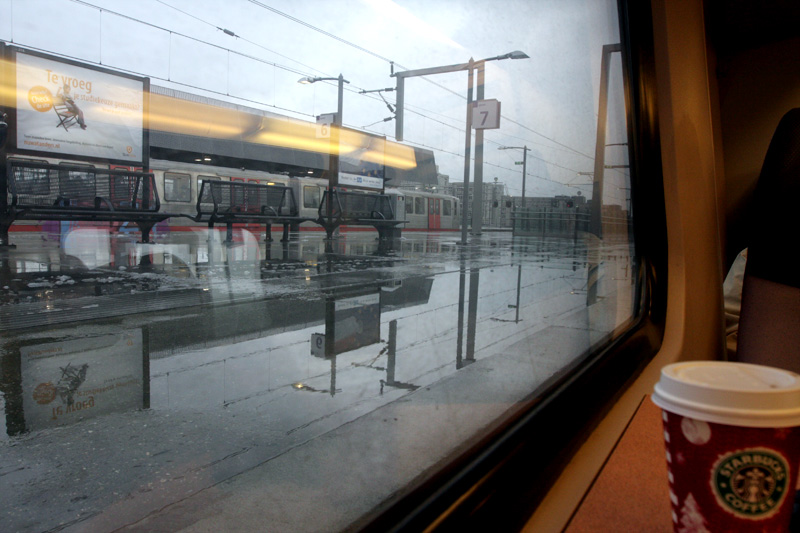
The trip from Amsterdam to Arnhem takes just over an
hour.
In no time, I was on a high-speed train to
Arnhem, where Crystal Cable and Siltech are headquartered. Once in Arnhem, I was greeted
by Crystal Cable and Siltech's Suzanne, their marketing person, and was hustled over to
the companies' headquarters, which is located in one of the two World Trade Center towers.
There I met Gabi van der Kley in her bright, spacious office.
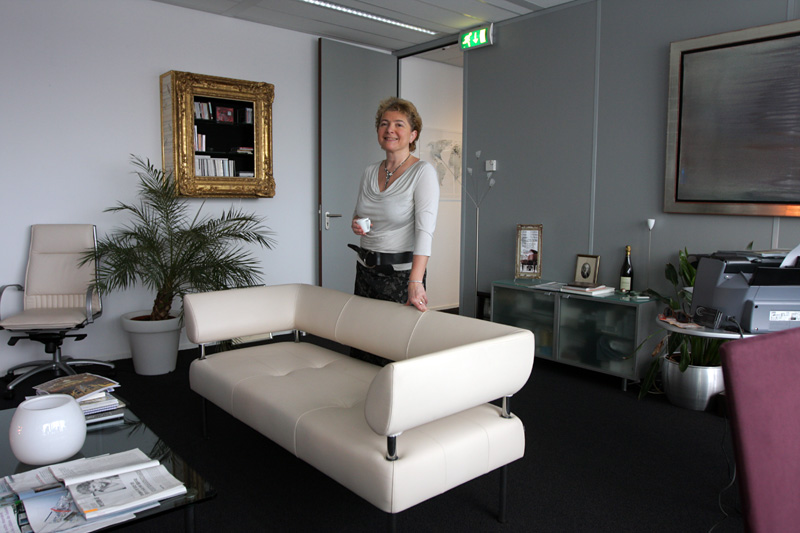
In Gabi's office.
I learned quite quickly that Gabi and I have four
things in common: we're workaholics, we travel constantly, we respond to most e-mails
within a minute, and we can almost always be seen with coffee in hand. Gabi made me a cup
and gave me a quick tour of the offices, which all have an...
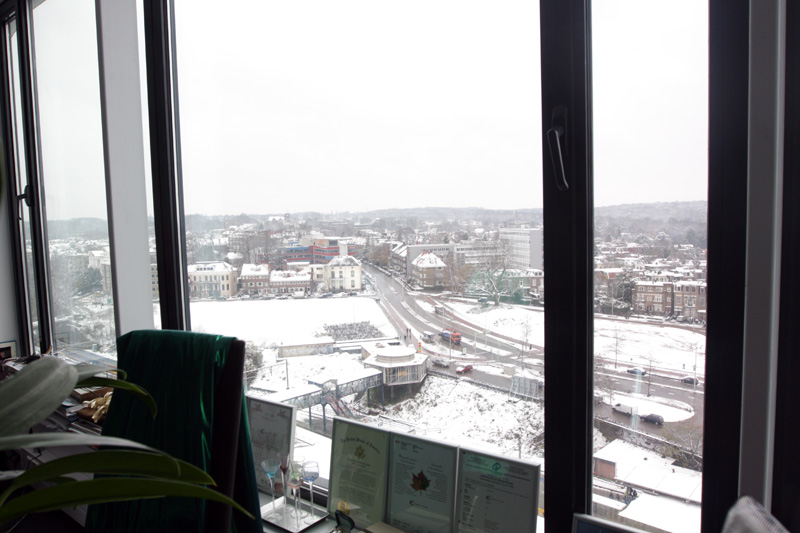
The view.
...impressive view of Arnhem below. Arnhem, known
for "The Battle of Arnhem" in World War II (the subject of the movie A
Bridge Too Far), has a population of 150,000. However, I could tell the moment I
arrived that our stay here wouldn't be long. Gabi was eager to get me to the factory,
which is located just outside of Arnhem in an industrial park, to see and hear the new
Arabesque speaker. In no time flat, we finished our coffee and were speeding away in her
car. As I said, this was literally a trip involving planes, trains, and automobiles.
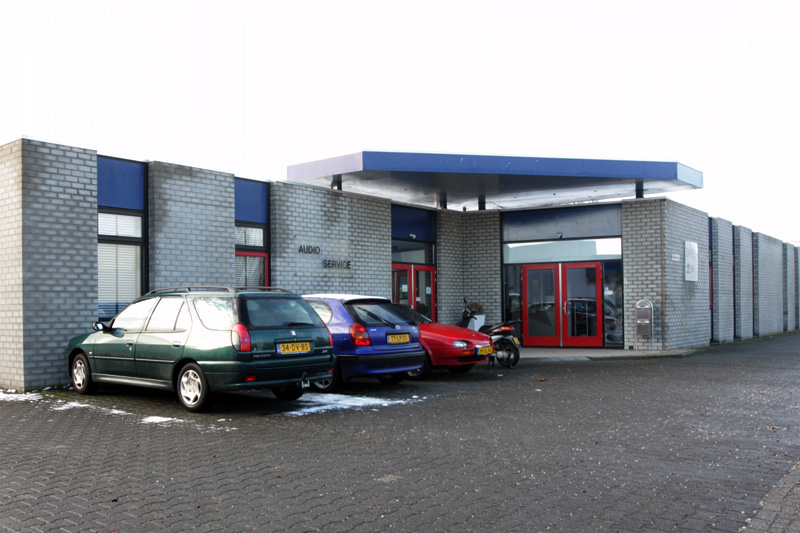
The factory.
The factory, which houses both companies, is
large and accommodates both research and manufacturing. With many cable companies, this
isn't always the case. The wires are made elsewhere and just distributed from a shop. In
the case of Crystal Cable and Siltech, except for the actual forming of the wire itself,
almost everything happens here, again something I'll explain in the factory-tour article.
Once inside...
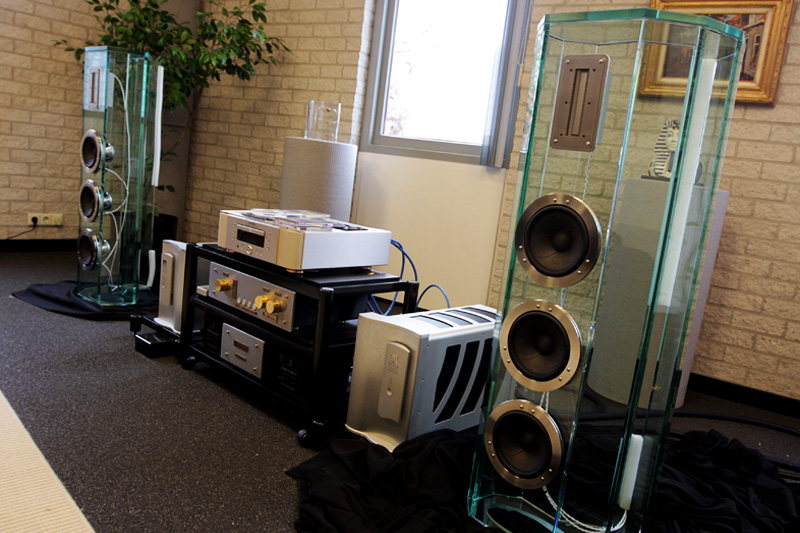
The listening room.
...Gabi hustled me into the listening room, which
is toward the back of the building. I then saw the Arabesque. Although I'd seen renderings
and even a couple of pictures of the speaker, seeing the Arabesque in person was something
different altogether. I was quite surprised by the uniqueness of the design. Furthermore,
Gabi's concept for the speaker was now clear -- crystal clear.
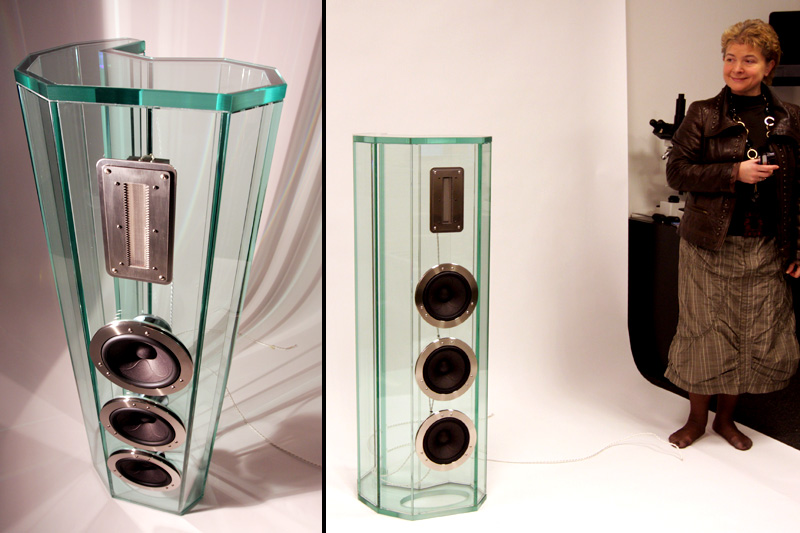
Have you ever seen a company president look so proud?
About the name: Arabesque, which is an Arabic
word, refers to the shape, which is in evidence when you take a top-down look at this
speaker. Gabi had the speaker placed on a large sheet of white photographic paper to give
a better view of the rather elegant design.
About the glass: That was Gabi's idea from way,
way back. Not only did she feel that it would give the speaker visual appeal, but that it
would also match the transparent look of the company's cable products, which, not
coincidentally, also correlates with her company's name. For her, glass seemed like the
only way to go -- any non-see-through material was simply out of the question. Quite
simply, her speaker had to be clear and it had to conform to that shape.
But that doesn't mean that turning Gabi's glass
vision into reality was easy, particularly when two of the goals for it were to be
technically proficient and musically satisfying. Furthermore, the Arabesque's
asking price is not insubstantial: the estimated list price is 45,000 euros per pair
($62,630 at the current exchange rate). At that price, it can't just look good; it has to
sound impressive too. So Gabi brought together a team to help ensure the whole thing
turned out the way it should.
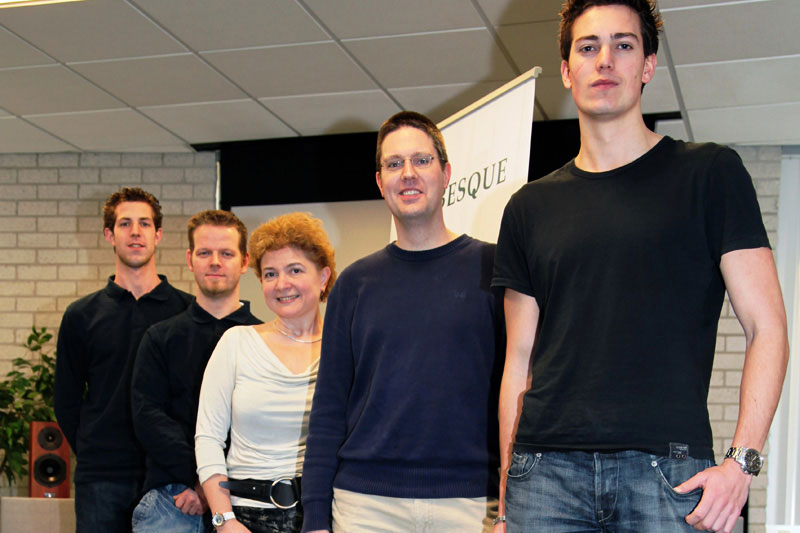
The Arabesque design team, from left to right: Arvid
Surstedt, Stefan Arts, Gabi van der Kley, Pascal van den Heuvel and Arjan Speklé.
While Gabi conceived of the speaker concept, her
team helped bring it to life -- visually and sonically -- which, they tell me, was a
complex task. In fact, making a cabinet like this one had never been done before.
So, in order to make Arabesque a reality, Crystal Cable had to work closely with
Germany-based Finiglas, a company with the technical chops to create such a cabinet. But
that was only part of the challenge. Getting the product to work acoustically was
yet another. This is where...
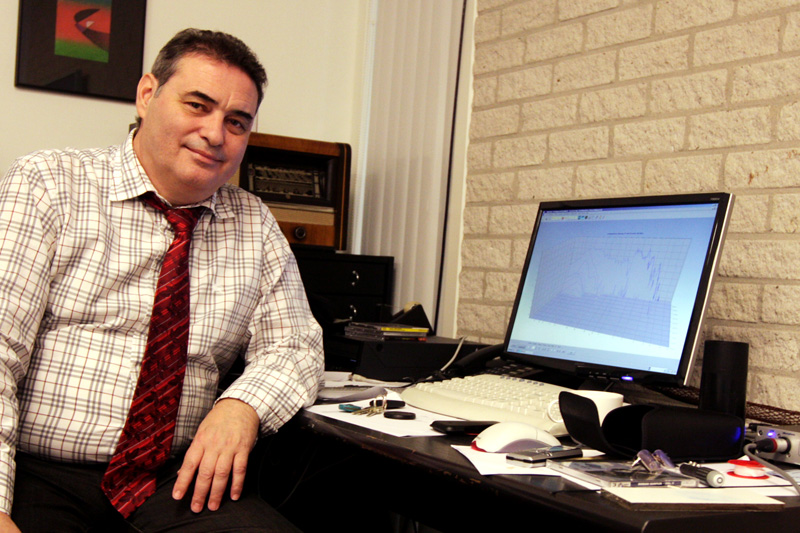
Edwin van der Kley, also part of the team.
...Edwin van der Kley stepped in. Edwin may run
Siltech, but he has his hands in the technical workings of both companies. Edwin holds a
masters degree in electronics and has worked in the audio industry for 30 years. His main
goal in life seems to be to figure out how things work, and to figure out how to make
things work, like a glass loudspeaker. Over the duration of my visit, he and I talked at
length about loudspeakers, cables, and, even cameras, including the one I was using to
shoot these pictures. Everything electrical and mechanical seems to fascinate him.
Therefore, he embraced the challenge in taking Gabi's vision and making it something real
and credible.
In order to make the speaker work properly and
get the work done efficiently, he employed not only conventional loudspeaker-design
software, as most manufacturers do, but also a complex software product called COMSOL
Multiphysic, along with a consultant from COMSOL, Frank de Pont, to assist him.
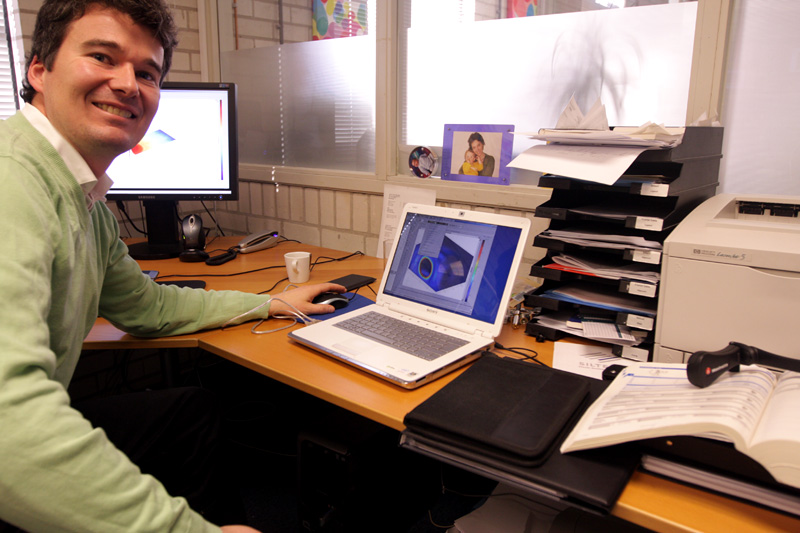
COMSOL consultant Frank de Pont worked with Crystal
Cable on the Arabesque project.
COMSOL is a multiphysics software application
that, with sufficient technical knowledge, can be used to simulate anything
before it actually gets built. NASA Technical Briefs Magazine, an official NASA
publication, voted it Product of the Year in 2006. NASA researchers use it to simulate
some of their most ambitious projects before they ever get made. However, this isn't
a product for a do-it-yourselfer. Despite having post-secondary education in computer
science and working in the computer field for 13 years, I am incapable of using this
program. Furthermore, it's a "tool" that requires a thorough understanding of
physics to make use of it. It's used in the aerospace and auto industries, and can be used
almost anywhere else you can think of where real physical products integrate with the real
world. Its capabilities extend far beyond what the loudspeaker industry needs, and it is
far more advanced than the loudspeaker-design programs that are readily available today.
However, because of that, COMSOL can be used as the ultimate environment in which to
simulate all aspects of a loudspeaker's performance -- inside and out -- before the first
prototype ever gets made.
I was given a quick example of the type of
simulation that would be done. The shape of the Arabesque was created in COMSOL, the
materials used were specified, as were all the dimensions. Then, a moving diaphragm was
also created (i.e., a driver), placed on the cabinet, and then instructed to move
at a certain frequency. What resulted was a simulation of how the air inside the cabinet
would respond and how resonances would build up. From that, the designer can tweak any
parameter he wants until the optimum result is achieved. According to Edwin, in the case
of the Arabesque, the design team was able to get the shape just so and was able to get
away without using damping material in the cabinet, something he feels improves the
speaker's performance.
Edwin told me that Siltech cut its teeth with
COMSOL on the company's Pantheon speaker project by investing considerable resources to
make it work and get tangible results. He also said that the process wasn't for the faint
of heart. The COMSOL program costs big money, the people who use it must have tremendous
knowledge in order to glean useful results, and despite being able to model things
virtually, it sometimes take a lot of time to attain results from simulations that are
quite complex. Edwin said that in the development of the Pantheon there were some
calculations that took a week of computer-processing time! One crash and days, if not
weeks of work could be lost.
In the end, Edwin deemed the investment in all
that research to be worthwhile. The Arabesque team was able to model the speaker entirely
in the digital domain and predict its behavior with high precision before the first
prototype was ever made. Obviously, this is tremendously beneficial, given the difficulty
of building a glass cabinet the way Gabi wanted it to be. Furthermore, once Crystal Cable
actually built the first pair of speakers, which is what I saw in the listening room, the
speakers worked just as COMSOL predicted. That's not to say that the speaker is 100%
finished straight out of the computer, but COMSOL helped to get it most of the way there
without actually having to build a thing.
Out of the virtual work and into the real world,
there's still some tweaking and fine-tuning to be done to the Arabesque, which is what
you'd expect. Not everything can be done by computer, or even in a measurement lab, which
is also where Edwin spends a lot of his time. Still, the Arabesque prototype I heard holds
great promise and shows how much can be done when care and attention are preserved from
the outset. The speakers exhibited outstanding clarity through the midrange and treble,
well-controlled bass, and far greater output capability than I imagined they would have.
Edwin played musical passages that were well in excess of 105dB and joked afterwards that
although the speaker is made from glass, it's certainly not easy to break.
No doubt, some things will change here and there
-- the tweaking goes on -- but Edwin says that the core design will remain unchanged, and
he gladly divulged the design details to me. Technically, the Arabesque is a two-way
design, something Edwin stipulated as a design criteria up front, based on his feeling
that the team could design this better as a two-way than a three-way. It uses a large
ribbon tweeter from Raal crossed over at about 2300Hz to three 6 1/2" Scan-Speak
Illuminator mid-woofers working in parallel. Second-order (electrical) filters are used to
cross over the woofers to the tweeter. The ribbon is a high-sensitivity design (it's rated
at 95dB for 1W input), and because the three woofers are operating together and
reinforcing one another, the overall sensitivity of the speaker is said to be 95dB.
Impedance is 4 ohms, with a 2.7-ohm low point somewhere in the bass.
According to Edwin, measurements they've done on
the woofers and ribbon tweeter indicate very high output capability with low distortion.
In fact, he's claiming that at some frequencies, the speaker is able to reach in-room
peaks of 118dB! Certainly, what I heard played showed that the speaker can play
startlingly loud without strain, something necessary to deliver the full impact of an
orchestra or the robust sound of a grand piano, which Gabi cares about dearly.
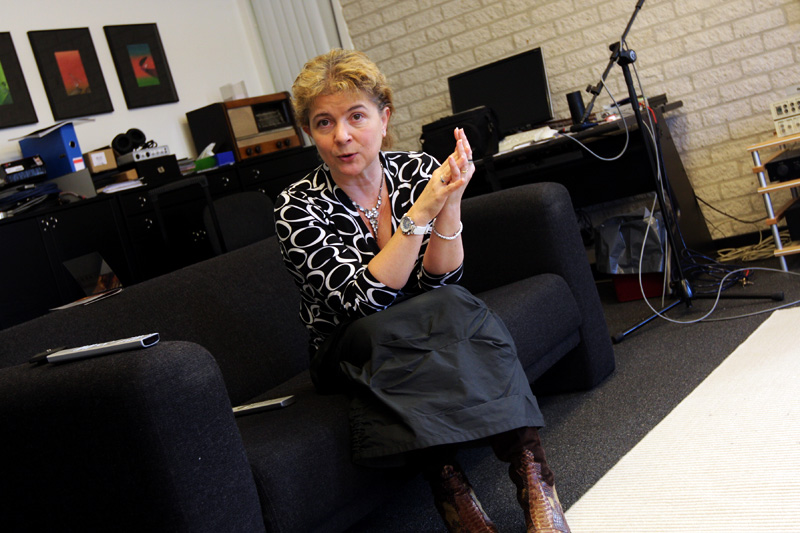
Gabi is clear about Crystal Cable's goals.
Tech talk aside, when we're talking about Crystal
Cable, it's important to reiterate Gabi's three criteria for the brand: visual appeal,
technical proficiency, and musical satisfaction. Many people who know about Crystal Cable
might know that Gabi is a pianist. I think it's discussed in the company's literature. But
what many don't know is how accomplished a pianist she is.
Gabi was born in Hungary. She explained to me
that when she was very young she picked up playing the piano like that. She then
developed an insatiable appetite to practice it, so she was playing every day of the week
for hours on end. Gabi went on to receive professional training, and by age nine she began
playing concerts, eventually touring the world and playing in countries as far away as in
Japan and in venues like La Scala in Milan. Playing and touring carried on for about 14
years. At 23, Gabi retired from playing, got married, and started her family. She now has
four children, the oldest of which is 16.
When Gabi started Crystal Cable about five years
ago, her passion for music remained and she instilled that ideal into the company.
Therefore, all three aspects -- visual, technical, musical -- must work harmoniously
together, something she feels makes Crystal Cable unique. Her cables, and now her speaker,
are a testament to those three things. All must be present and nothing shortchanged.
The Arabesque's official debut will be at CES
2009 in Las Vegas, another place where it's easy to be up to "no good."
I'm actually eager to see how the marketplace reacts to the Arabesque. It's new, unique
and, in many ways, very exciting, because it's clearly so different from almost
every speaker on the market. If it finds an audience and takes off, the Arabesque could be
the start of something really new in high-end audio.
That's the story of Amsterdam, Arnhem and the
Arabesque. Remember, you read it here first. Look for more exciting discoveries during the
rest of 2009.
...Doug Schneider
das@soundstage.com
For more information about Crystal Cable, visit www.crystalcable.com.
|

